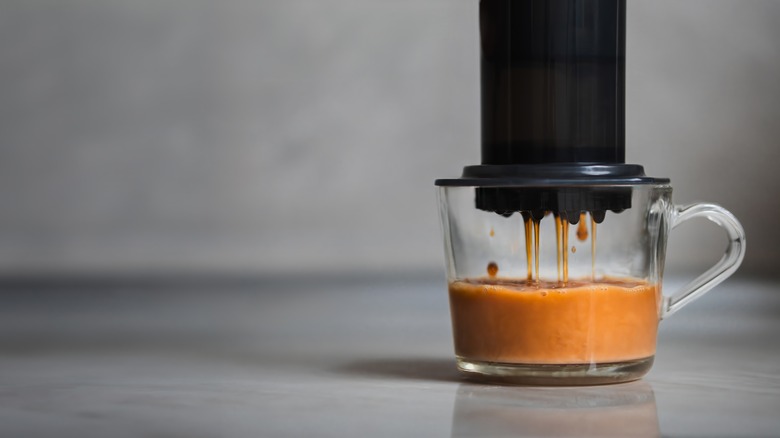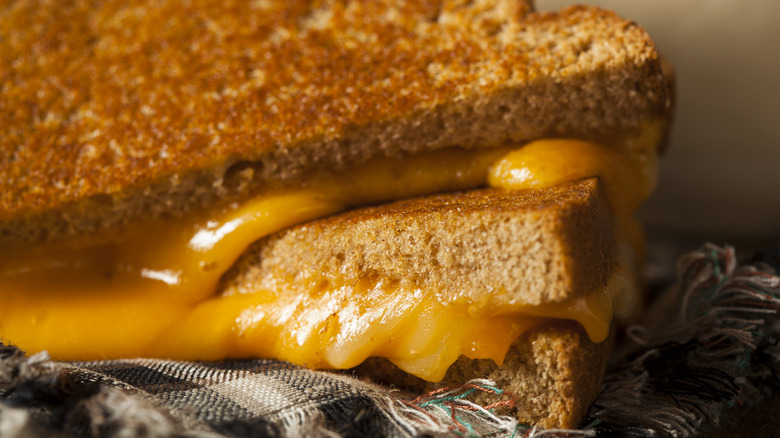13 Alton Brown Cooking Tips You Should Know By Heart
Long-time fans of TV personality Alton Brown know him as a food scientist, former Food Network star, and home chef. While he first made a name for himself on his long-running documentary series "Good Eats," Brown is also beloved for his light-hearted approach to home cooking. This makes his recipes feel both accessible and innovative, as well as perfect for home cooks and chefs at any level.
From Brown's best-selling essay collection, "Food for Thought," to his playful Instagram captions to the expansive recipe collection on his website, he's become a reliable and consistent resource in the culinary world. Known for sharing great cooking tips by making his content incredibly straightforward and digestible — yes, pun intended — he is chock full of foodie quips, cooking insights, and go-to meal-prep tips.
For as extensive and expansive as his knowledge is, though, it's rarely intimidating. In fact, plenty of his suggestions are also incredibly easy to remember. With this in mind, we've rounded a few Alton Brown cooking tips worth committing to memory, which you can use to incorporate a whole host of great ideas into your own meal-prep.
1. Add bacon to classic egg salad
Along with tuna salad, it's widely agreed that egg salad is a much-loved sandwich filling. But if you've ever felt this easy lunchtime staple has gotten a little too predictable, Brown revealed his top tip in a post on his Instagram, and it's one worth remembering. Apparently, Brown's favorite way to up-level a classic egg salad sandwich is by adding bacon.
This is straightforward enough, but the tip doesn't stop there. After cooking the bacon until it's perfectly crisp, Brown also says in his recipe that you should use the remaining bacon fat, too. Pouring the bacon fat into your roughly chopped eggs reduces waste and, as it cools, binds ingredients together. You'll gently fold everything together — along with any other desired ingredients. Brown also suggests red onion, chives, and hot sauce as other great ways to really give this dish a kick. Any hot sauce will do, of course, but Frank's Red Hot is Brown's preferred brand for this particular version.
Serve your finished salad in a classic sandwich, on its own, or go with Brown's approach, which is plated open-face over toast. He also suggests serving immediately, although it can be saved and stored in the refrigerator for up to three days.
2. Mayo makes the creamiest scrambled eggs
It often feels as if almost every professional chef claims they've discovered the very best way to make the perfect scrambled eggs. Gordon Ramsey's egg recipe is technique-focused and seems to go viral every few months; Dame Prue Leith claims a blender is necessary for truly fluffy goodness in the morning. Brown, on the other hand, has his own spin. He says his personal secret weapon is the addition of mayonnaise to scrambled eggs.
In Brown's 2016 book, "Everyday Cook," he says mayo is the best way to ensure perfectly creamy scrambled eggs, and you don't need much. Adding just one teaspoon to your egg mixture before scrambling should do the trick. Plus, in case you're wondering why this works so well, everyone's favorite food scientist even dives in on a chemical level.
According to his recipe for "Scrambled Eggs 3.0," the magic happens because these two ingredients are both emulsified foods. This means mayonnaise and scrambled eggs don't separate the way some liquids do. Instead, they work in tandem by blending together to enhance the overall texture. This leads to a breakfast full of perfect, creamy bites.
3. Swap gin for whiskey and you'll get this Negroni alternative
Over the past few years, the Negroni has managed to steal the spotlight as one of the trendiest cocktails on any menu. Served in a classic tumbler with a gin base, it's fairly straightforward to make. If you swap the gin for whiskey, though, then you have another drink entirely, called the Boulevardier. And, as it turns out, Alton Brown's favorite cocktails is the Boulevardier.
In order to make the perfect Boulevardier, then it's helpful to know that a classic Negroni is comprised of equal parts gin, vermouth Rosso, and Campari, plus an orange peel for garnish if you're feeling fancy. If you decide to add Prosecco, that's called a Negroni Sbagliato, which is a fresher, lighter spin on the classic. This bubbly addition turns your cocktail into a great spring or summer option.
By swapping out the gin for whiskey and ditching the Prosecco, Brown's preferred take becomes an ideal drink for warming up on cooler nights. If you love the idea but don't have whiskey, never fear. Rye or bourbon will do, as either will achieve the desired results — a Boulevardier that's slightly spicy and darker than your classic Negroni.
4. Toss your Brussels sprouts in bacon fat, too
Brown's love for bacon is well-documented. He even claimed on an Instagram post that he can't think of any dish that wouldn't be improved by adding this easy ingredient. But this next tip goes beyond simple addition. Along with chopping up a few slabs and crumbling bacon over your Brussels sprouts after cooking, one of Alton Brown's classic cooking tips suggest tossing the sprouts in the leftover bacon fat. This should be done after roasting.
This alone sounds great, but Brown's advice for great Brussels sprouts doesn't stop there. According to Brown's recipe, he also suggests mixing your sprouts and bacon together with roasted apples. Then, he uses a sauce made of Dijon mustard and maple syrup. The whole concoction gives a sweet, pungent, fatty burst of deliciousness, but in case you're still not sold, Brown calls the end result "downright magical." It's the perfect accompaniment to anything from a roast chicken to a classic Thanksgiving, with bacon addition promising a hearty, filling side.
5. For the perfect cup of coffee, freshly ground beans are best
It's no secret that Brown is a self-proclaimed coffee addict. He posts about his caffeine love often on Instagram and in an interview with Men's Journal, he says he couldn't live without his Aeropress. In an article about coffee on his own site, he offers another top tip. He says the best-tasting beans aren't ground in advance. They need to be ground immediately before brewing.
This is because Brown likens coffee beans to spices, and explains that they're technically full of essential oils. If you grind them too far in advance, you run the risk of losing all their best qualities, many of the oils and aromatic compounds break down after the first few hours of coffee being ground. But if you must pre-grind on your own or buy them ready-to-brew, rest assured. Brown has advice for that, too. You need proper storage, like a zip-top freezer bag with all the air removed. Once you have your perfectly ground beans in hand, Brown warns of other common mistakes that are worth keeping in mind. In short, less coffee makes for a bitter finish, great tasting water (whether or not it's filtered) is a must, and don't overheat your brew.
6. A bi-level cooking approach makes the best salmon
Of all the options, salmon is generally considered to be a fairly straightforward fish to prepare. Even so, as easy as it is to make, it can just as easily go wrong if you're not careful. Obviously, no one wants dry, overcooked, or rubbery fish, but Alton Brown says he combats this by using a bi-level approach to cooking salmon.
In case you're unfamiliar with this approach, it's pretty much cooking your salmon on two different levels. As Alton Brown writes in his king salmon recipe, he prepares this fish with a dual cooking technique that uses both the stovetop and the oven. First, sear the salmon on both sides. Then, finish the fillet off in the oven. The end result, according to Brown, is a perfectly seared exterior with a creamy center that's easy to recreate every single time — once you've mastered this initial technique, of course. Best of all, the ingredients list is incredibly simple, too. King salmon is especially important as it's meaty and slightly less delicate. Overall, it can handle the double cooking. Alton Brown recommends a cut that's 1½-inches thick. All you need on hand other than a good piece of fish is vegetable oil, salt, and pepper.
7. Enhance your pasta with homemade herb oil
When you're in a pinch for an easy weeknight dinner, fresh pasta coated in tomato sauce and topped with cheese is an obvious choice. But in Alton Brown's recipe for weeknight spaghetti, he enhances this simple go-to with two key elements: homemade sauce using canned San Marzano tomatoes and an herb oil featuring garlic, thyme, rosemary, basil, and pepper flakes.
It's important to note that the oil should be made first; blooming the herbs in hot oil accelerates the release of crucial flavor compounds. It's used as a part of the base for the tomato sauce — and, as Brown explains, offers a modification of flavor quicker than a long simmer of herbs you'd have to do otherwise. Brown also notes that you can make it in advance to use immediately, or strain into a jar, cover, and freeze until needed. Either way, once you've added your canned tomatoes and anchovies, you'll have an elevated take on this old stand-by.
And the cherry — er, cheese — on top? Brown says fancy, hand-grated Parmigiano Reggiano is hardly necessary. In fact, as he admitted in a cheeky post on Instagram, he just might be the world's biggest fan of Kraft Parmesan cheese. So, if you're craving this beloved mix of grated cheese and cellulose powder, Brown says that's absolutely allowed. Just don't forget the hot herb oil.
8. Add zing to your potroast with cocktail olives and raisins
It seems as if all the best pot roasts have that one secret ingredient the chef insists sets their recipe apart from all the many others out there. In Alton Brown's case, though, it's actually two secret ingredients: cocktail olives and raisins. One adds a complimenting sweetness that's still on the darker side, potentially paring with a red wine reduction. The other ingredient, olives, impart salt in a briny form that makes it more than one-punch sodium. Along with a braise made of tomato juice and balsamic vinegar, Brown's pot roast recipe promises a ton of flavor and a juicy, tender meat that can only be achieved after hours of roasting.
Despite the long cook time and quirky ingredients, the recipe itself is fairly straightforward and low-maintenance. But because it's all made within what Brown calls a "big ole pouch" of heavy duty aluminum foil, he shares two other important cooking tips worth remembering. First, flip your meat with tongs rather than a fork to avoid poking any holes in the meat. Second, place a sheet pan on the lower rack to catch any accidental spillage should your pouch still manage to spring a leak. In the end, thanks to the tangy, zesty mix and the unexpected addition of olives and raisins, you'll be left to enjoy a complex and rich pot roast that truly is unlike the others.
9. A clean, hot knife is key for slicing cheesecake
If you're looking for a delicious twist on a beloved dessert, Alton Brown suggests making pumpkin cheesecake instead of pumpkin pie. But anyone who has ever sliced a cheesecake before knows that depending on the consistency of the cake, mastering the presentation is easier said than done.
However, as noted in the recipe, Brown has a hot tip for getting that perfect slice — and we mean this literally. He says the key is to place your knife in a hot water bath, drying carefully, and then cutting into the cake.
Along with giving your knife a bath, Brown says it's also important to use the longest and thinnest blade you have. Then, as from the start, in between each slice, wipe your knife dry. This should yield the best result, but if all else fails, distract your diners with this recipe's combo of sweet and spicy, thanks to its crisp gingerbread crust.
10. Use pickle juice to make homemade mustard
Sure, you can easily pick up a jar or bottle of mustard in the condiment aisle, and there are plenty of different types to consider. But are any of those options the best mustard ever? If you ask Alton Brown, the answer is no, it's most certainly not. Instead, in a DIY mustard recipe on his website, he suggests making the ultimate version of this spicy condiment yourself. Best of all, his calls for a surprisingly fun ingredient: pickle juice.
In addition to dry mustard powder, salt, and hot smoked paprika, Brown also calls for apple cider vinegar — but it seems as though the half cup of pickle juice is what really kicks this recipe up from great to "the best ever." It's also worth noting that Brown specifically suggests using sweet pickle juice, but it does open the door for some experimenting. Try whatever you have on hand, or considering playing with the flavors to adjust your mustard accordingly. And if you prefer to DIY the pickle juice, too, take a peek at Brown's recipe for homemade dill pickles for tips.
11. Save leftover lobster shells for homemade bisque
Anyone who has ever had fresh, whole lobster before knows that it's not the easiest or cleanest of meals to get through. Plus, if you're dining at home, you're also left with a ton of empty shells at the end. Most people simply toss them out, but food scientist Alton Brown says this is a complete waste. Instead, you can use them as a base for a delicious lobster bisque — no lobster meat required.
According to Brown's "claw to tail" approach, all you need to do is drop your empty shells into a large, zip-top bag and pound away until they're crushed into small pieces. Then, using a Dutch oven, set to making the stock. After simmering your shells for an hour in a careful mixture of butter, vegetables, and dry sherry, you strain the stock. This is when you can finally discard your properly used lobster shells. As a final step, Brown relies on rice blended in with the stock to create a perfect, velvety bisque.
12. Season your filling for the perfect grilled cheese
There's nothing more comforting than a great grilled cheese. If you're in a pinch, it can be as simple as slapping together some butter, bread, and cheese before grilling it to perfection on your stovetop. But if you want to go gourmet, Alton Brown's recipe for chimney grilled cheese is definitely elevated. Rather than use plain slices, he grates a mixture of three different types of cheese and seasons that with dry mustard, smoked paprika, and black pepper.
While you could do this as a new step in your normal approach to grilled cheese, Brown's innovation doesn't stop there. Instead of a stove, Brown prefers to grill his concoction up using a cast iron pan, natural hardwood lump charcoal, and a chimney starter. In case you're unfamiliar with the concept of a chimney starter, it's basically a metal cylinder used to fire up your charcoal before grilling.
Brown gets his going while he preps his grilled cheese, then places the chimney over the bread throughout the process and for varying increments of time, until finally his seasoned cheese mixture is melty and starting to brown. And if you do opt to try his chimney starter approach, Brown has another tip. He suggests making this particular recipe as a precursor to whatever you're planning on grilling, so that the charcoal doesn't go to waste.
13. Swap peanuts with pistachios for a fun twist on this classic candy
For any die-hard candy fans out there with a deep-seated love for the store-bought classics, this tip will either delight you or upset you. Not only does Alton Brown make homemade Butterfingers, but he does something some lovers of this go-to chocolate bar are bound to find sacrilegious. He swaps the peanuts for pistachios.
Seeing as Butterfingers are traditionally made up of only two flavors — crispy peanut butter and milk chocolate — this is a big change. This tip is definitely intriguing, but Brown also warns that making candy at home isn't as sweet as it sounds. Tempering your chocolate is critical for an appealing end result, and it requires a digital thermometer and a healthy dose of patience.
This admittedly sounds intimidating, but Brown still promises that the pay-off is completely worth it. As for the pistachios over peanuts, consider this version a slightly elevated and more grown-up alternative to the original recipe. It can also be great for anyone with a specific allergy that still craves a Butterfinger crunch.













